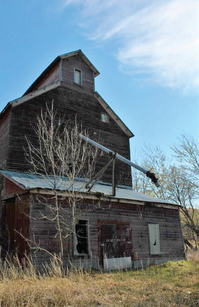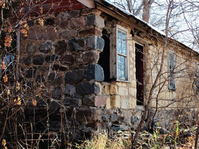Most people have their own moments in time about which they can brag and times that they would rather leave hidden. When it comes to history, it is a disservice to the decedents to paint the past with only certain colors from the crayon box. Our history influences our present and our future; and it is imperative that we know and understand all of the truth about our past, the good, the bad, and the ugly, so our view of the present is not distorted by halftruths and a selectively gilded memory.
Buildings still stand from the abandoned colony on the east side of the James River near Milltown, South Dakota, located in Hutchinson County.
The buildings that remain at Milltown were placed on the National Register of Historic Places in 1982. The town of about a dozen residents lies ten miles east of Parkston, South Dakota. South Dakotans have a special interest in the Hutterites and their communal farms. Approximately 1,300 Hutterites, virtually the entire population, migrated to America, from a historical standpoint South Dakota was the location of the first settlements of Hutterites when they migrated from Russia in 1874 to 1879. In fact, the first colony established in North America, Old Bon Homme, is still in existence. It is located a short distance west of Yankton, South Dakota, near the town of Tabor. Another reason for local interest in the Hutterites is that South Dakota has the largest number of colonies and population of any state in the United States (Canada now has the larger part of the Hutterite population with more than six times the number in South Dakota). Modern transportation and communication have made local citizens aware of and interested in knowing more about the Hutterites, their beliefs and their practices.
The colony was founded in 1886 as the first daughter colony of Bon Homme. The Hutterites are an extremely conservative group, which has over a 450 year history. They have adapted with the times and new technology, but they have established certain traditions that have not changed over time. Their unique way of life is relatively uninfluenced by the world around them. The Hutterites are a
religious sect, an ethnic group, and a communal brotherhood; they possess a culture and an economy. Among the many immigrant groups that have settled the plains, the Hutterites are unique in the degree to which they have resisted assimilation. They have retained their German language, their schools and socialization processes, their clothing and their life style. Their Anabaptist religious beliefs are the glue which has kept the brethren together, while their strict adherence to the principle of holding all things in common sets them apart from other Anabaptist groups like the Amish and the Mennonites.
The colony ceased to exist in 1918 when the entire colony moved to Manitoba to form the Rosedale Hutterite Colony (Elie, Manitoba, Canada). During World War I, because of their German heritage and their refusal to participate in the war effort, strong sentiments developed against the Hutterites. Several young men were arrested and imprisoned. Attacks were made against the colony and animals were stolen and sold to buy war bonds. Because of the extremely harsh treatment, the colony left as they were guaranteed by the Canadian officials that they would receive military exemption. The first colonies migrated that year. By 1922 when the state legislature decided that the profit-making Hutterite colonies could not be considered a religious corporation and abolished their charters, almost all the colonists had left. By 1934 Bon Homme was the single remaining colony. In the 1950s, the fear of communism brought about renewed attacks on the Hutterites in South Dakota. The Hutterites ironically were completely uninterested in state or
international politics, yet their communal way of life was perceived as a red menace.
New legislation prohibited the growth of colonies beyond established limits, in an effort to keep their sizes down. Despite this renewed persecution, the Hutterites have stayed and thrived in South Dakota. Today there are colonies in three other states, North Dakota, Montana and Minnesota, also three Canadian provinces, Saskatchewan, Manitoba and Alberta.
In order to fight restrictive legislation, the colonies have pooled their resources and sought legal counsel. Also, the prejudice against them is less severe than in earlier decades. During the Second World War, Hutterite men were allowed to work in civilian corps, building non-military government projects in camps financed by the Hutterite colonies. There are 36 colonies in South Dakota today and the population is increasing. The Hutterites suffer a surprisingly low rate of defection despite the rigidity of their style of living. However, with exposure to contemporary material goods, such as radios, there has been a noticeable rise in the age at which young people marry. However, despite these problems the Hutterites remain an unusually cohesive and stable group. And, as a group which expresses its beliefs and religion in its living habits, the Hutterite Brethren represent a unique and historic phenomenon.
On the other side of the James River, originally part of the Hutterite Colony sits the land that houses the Milltown Park. The park was purchased from the Milltown Hutterite Colony in 1922, and early
reports note the construction of cabins in the 1920’s and the addition of the ballroom at a later date. The park became popular for roller skating, ball games, picnics and horseshoe tournaments. But arguably, Island Park became best known for its ballroom and dances. Known to many as just “Milltown”, the Island Park Pavilion was one of the most popular and loved dance halls of all time in South Dakota. It was built in 1920 but a year later burned to the ground after being struck by lightning. In 1923 it was rebuilt and became more popular than ever. It hosted many dances and you could see and hear your favorite band for only ten cents. For the first thirty plus years orchestras and big bands were the norm until rock and roll came on the scene in the late fifties.
Starting in 1920 and progressing until the final year of existence in 1995 there were a number of owners and managers of the pavilion. In addition to dances, there was roller skating as well as many other activities and community events. Milltown was never a very large town but was a very picturesque community located along the James River. Over the years flooding took its toll on the area but could never stop the fun at Island Park. It lasted until the pavilion closed and was torn down in 1995. Not only did the memories remain but much of the lumber that was part of the building was saved by some area residents and used to build other structures. Gone but not forgotten, Island Park was one of the shining stars in the great South Dakota Ballroom era.






